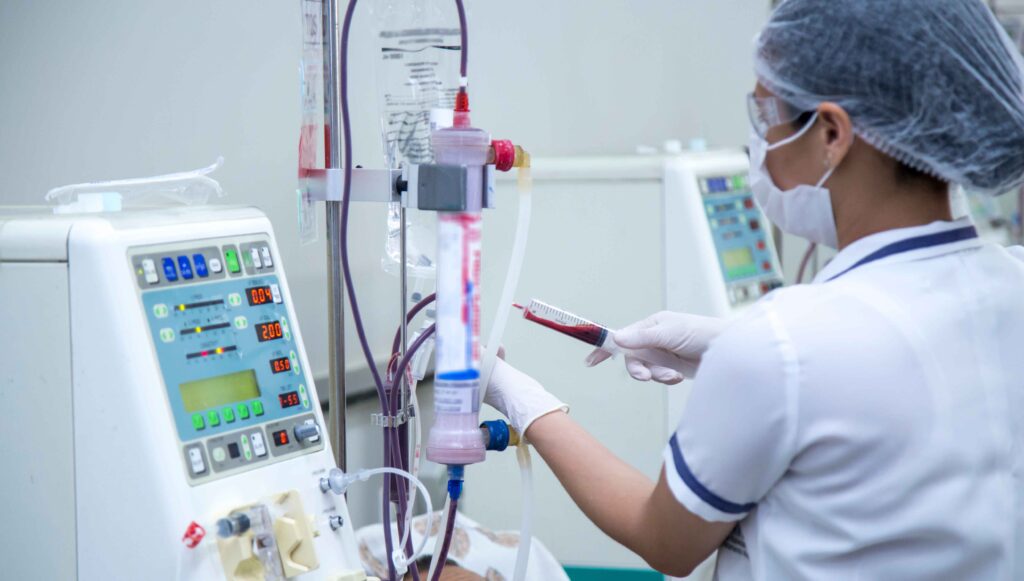If you are searching Hepatitis B Vaccination For Individuals on Dialysis Hepatitis B is liver infection due to transmission of the Hepatitis B Virus into one’s blood stream. Hemodialysis patients run a higher risk of becoming infected by this virus due to their blood being circulated through extracorporeal circuits for Hemodialysis..
Here Are a Few Points to Remember in This Context
1. Patients on dialysis require twice the standard dose of the vaccine
Hepatitis B vaccines in India are typically provided in vials of 1 ml. The patients on dialysis require 2 ml at a time.
2. You will have to take 4 doses spaced out over time
You will have to take twice the dose (i.e., 2 ml) 4 times to finish your course of vaccination. You have to administer a 2 ml injection on Day 0, Month 1, Month 2 and Month 6. This implies that if you have already taken the first 2 ml dose today, you have to take the second 2 ml dose after one month, the third 2 ml dose after another month and lastly the fourth and final 2 ml dose after 4 more months of the third dose. Example dates may be
- 1st January – First dose
- 1st February – Second dose
- 1st March – Third dose
- 1st July – Fourth dose
3. Undergoing a test if you are immune to the Hepatitis B Virus
After you have had 4 doses of the vaccine, you need to see if you have been well protected against the virus two months after the last dose. In the given example, this would be done on 1st September. This is checked by having a test called the Anti Hepatitis B Surface Antibody Titre. If the Titre value is more than 10 IU/ml, then you have been properly protected.
Also Read: Prepare Yourself for Dialysis Side Effects
4. Follow-up test yearly
With the Hepatitis B vaccine various individuals are protected to varying degrees and this protection persists for varying periods of time. The policy is to undergo a yearly test for the same Anti Hepatitis B Surface Antibody Titre. If your titre level is below 10 IU/ml, you are advised to take a booster dose (one dose of 2 ml of the vaccine).
Annual Anti Hepatitis B Surface Antibody Titre < 10 IU/ml – Booster dose of 2 ml
- Titre > 10 IU/ml but < 100 IU/ml – No booster needed for another year
- Titre > 100 IU/ml – No titre checking ever needed and no need to get a booster for your whole life
5. Non Responders
A few individuals do not get affected by the Hepatitis B vaccine. Even after receiving the full vaccination series (even two times) their titre level is still below 10 IU/ml. That means they are not well protected against the Hepatitis B virus. They ought to take proper precautions to prevent them from getting infected.
Conclusion
Patients on dialysis are at much greater risk of becoming infected with Hepatitis B because of the invasive treatment they are receiving and the possible exposure to infected Hepatitis B Vaccination For Individuals on Dialysis equipment, yet the Hepatitis B vaccine provides the essential protection when used correctly.
Frequently Asked Questions
Q. Is the hepatitis B vaccine necessary for dialysis patients?
Yes, hepatitis B vaccine is needed and should be administered to dialysis patients as they are an at-risk population with a higher risk of Hepatitis B Virus (HBV) infection.
Q. What is the schedule for hepatitis B vaccine for dialysis patients?
There are four doses 0, 1, 2, and 6 months.
Q. Who cannot take the hepatitis B vaccine?
You must not receive the hepatitis B vaccine if you have a history of a severe allergic reaction to a dose of the vaccine given before or a severe reaction to yeast or any other vaccine component.
Q. Who is at risk for the HepB vaccine?
The HepB vaccine is indicated for all children and adolescents under 19 who have not previously been vaccinated, and individuals 19-59 years of age. individuals 60 years and older.
Q. Which hepatitis cannot be vaccinated?
The Difference Between Hepatitis A, B and C | Hepatitis NSWHepatitis C and Hepatitis D do not have vaccines yet, although Hepatitis B vaccine also works to prevent Hepatitis D infection. Vaccines for Hepatitis A and B exist, of which Hepatitis B is used to prevent co-infections of Hepatitis B and D.



